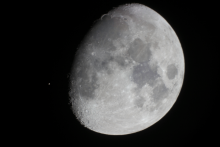Listen to today's episode of StarDate on the web the same day it airs in high-quality streaming audio without any extra ads or announcements. Choose a $8 one-month pass, or listen every day for a year for just $30.
You are here
Moon and Aldebaran
You don’t need a thermometer to take the temperature of a star — at least not a bright one. All you need is your eyes. Cooler stars look orange or red, hotter stars are blue or white, and in-between stars are yellow.
A star on the cool end of the scale shines near the almost-full Moon tonight. Aldebaran is the eye of Taurus, the bull. It’s to the lower left of the Moon at nightfall, and even closer to the Moon in the wee hours of the morning. Blocking the bright Moon with your hand will help you discern the star’s color.
Aldebaran’s surface temperature is about 7,000 degrees Fahrenheit. By comparison, our yellow Sun is about 10,000 degrees.
Aldebaran is cooler because it’s all puffed up. It’s quite late in life, so it’s undergoing changes in its core. Those changes cause its outer layers to expand. As the gases in those layers spread out, they get cooler — and Aldebaran gets redder.
A couple of other colorful stars align below Aldebaran and the Moon in mid-evening. Both are in Orion the hunter. Betelgeuse is bright orange, so it’s about the same temperature as Aldebaran. But Rigel is blue-white. Its surface blazes at more than 20 thousand degrees.
But those aren’t the limits of stellar temperature. The coolest true stars have a temperature of about 5,000 degrees, so they’re deep orange or red. And the hottest sizzle at more than 100,000 degrees. They look blue-violet — a colorful indication of their temperature.
Script by Damond Benningfield




